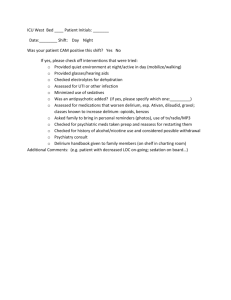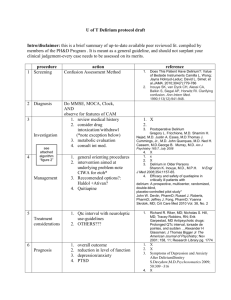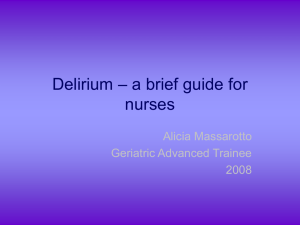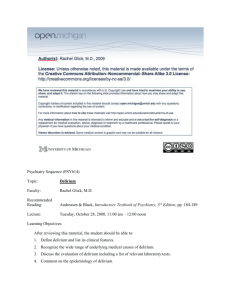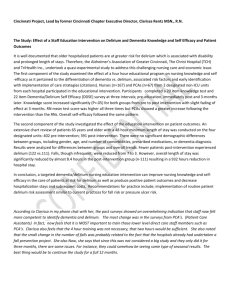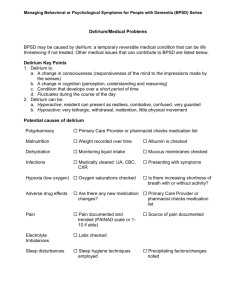Delirium
advertisement
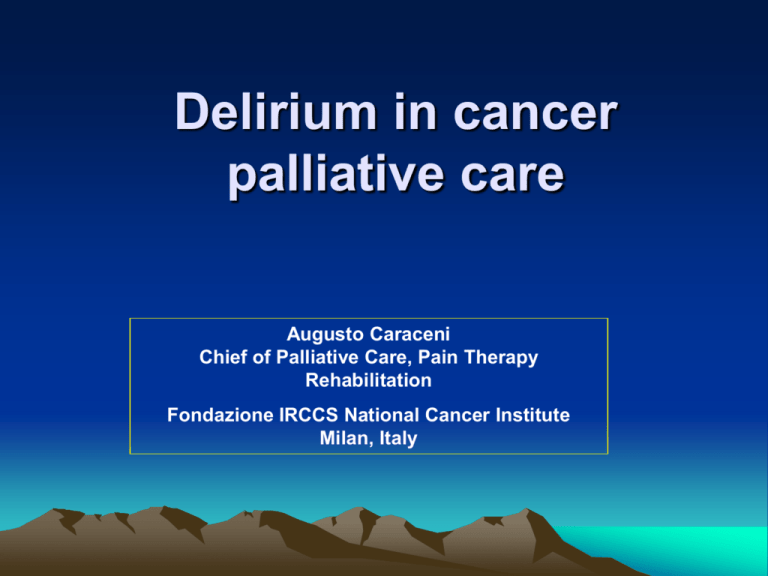
Delirium in cancer palliative care Augusto Caraceni Chief of Palliative Care, Pain Therapy Rehabilitation Fondazione IRCCS National Cancer Institute Milan, Italy In the beginning • 29 April 1965 to Dr RobertTwycross “.... I hope we will continue to reduce this figure when we have St Christopher’s and when we learn more about the relief of mental suf fering and confusion, which as you see remain the big problem” • 16 August 1976 To Prof. Exton Smith “…the confusion which many patients experience …we agreed that, all too often, this is and remains somewhat of a mistery” David Clark: “Cicely Saunders Founder of the Hospice movement selected letters 1959-1999” Oxford University Press 2002 A problem of definition ? • Ippocrates frenitis • Celsus (25 b.C – 50 a.C.) and then Areteus from Cappadocia delirium • Greiner 1817 Verdunkelung des Bewusstseins (Obnubilation of consciousness) • Chaslin 1895 La confusion mental primitive • Lipowski 1990 Lipowski and the modern concept • “Delirium is a transient organic mental syndrome of acute onset, characterized by global impairment of cognitive functions, a reduced level of consciousness, attentional abnormalities, increased or decreased psychomotor activity, and a disordered sleepwake cycle” Lipowski Z.J. Delirium: acute confusional states OUP 1990 Delirium DSM IV diagnostic criteria • Disturbance of consciousness (i.e reduced clarity of awareness of the environment) with reduced ability to focus, sustain and shift attention • Change in cognition or the development of perceptual disturbances • Develops in hours to days and fluctuates • Is caused by the direct physiological consequence of a general medical condition Diagnostic and statistical manual of mental disorders (DSM) IV – TR APA 2000 Consciousness (awareness of self and environment) as a filter controlling the quality and quantity of stimuli reaching consciousness taste smell touch sound sight Environment pain Body breathing body position sense memories Unconscious hopes hunger fears From Averil Stedeford in: Bates TD (Ed) Contemporary Palliation of Difficult Symptoms Balliere’s and Tindall, London 1987, Br J Hosp Med 1978; 20 (6) : 694-698, 703-704 Consciousness and attention • We are always conscious of something. The ability of the brain to have different levels of awareness of stimuli and experience is dependent on attention which can be viewed as the gateway to awareness Pathogenesis, the ascending reticular activating system Moruzzi and Magoun 1949 Reproduced from Magoun 1952 Conscious states = wakefulness and sleep • Cholinergic n. (opioids) Cortex • Noradrenergic n. (Clonidine) Thalamus • Histaminergic n. (prometazine) • Dopaminergic n. (haloperidol) • Serotonergic n. (ssri) • Gabaergic (Benzodiazepine propofol) Pathological states of consciousness Clinical condition Wakefulness Awareness Coma Absent Absent Vegetative state Present Absent Abnormal Abnormal Delirium Epidemiology of delirium comparing oncology with palliative care with elderly populations Population Authors Prevalence Incidence ≥ 70 Francis (1990) 16.0 06.0 ≥ 65 Levfkoff (1992) 10.5 31.3 ≥ 70 Inouye (1993) 25.0 ≥ 70 Inouye (1996) 18.0 Oncology Ljubisavjevic (2003) 18.0 Oncology Gaudreau (2005) 16.5 Hospice Minagawa (1999) 28.0 PC Unit Lawlor(2000) 42.0 45.0 Homecare Caraceni(2000) 28.0 - Dying patient Massie et al.(1983) From Caraceni & Simonetti The Lancet Oncology In Press 85 Differential diagnosis Clinical Aspect DELIRIUM DEMENZA ACUTE PSYCHOSIS onset acute insidious acute 24 hour course fluctuating stable stable Level of consciousness reduced spared spared Attention abnormal Initially spared Can be abnormal Cognitive functions abnormal abnormal Can be compromised Hallucinations Often visual Usually absent Usually auditory Delusions Poorly organized impersistent Often absent Complex and persistent Psychomotor activity Increased, reduced, mixed, fluctuating Normal Variable with bizzarre behaviour Involuntary movements asterixis, myoclonus or tremors Usually absent Absent EEG abnormal* abnormal* normal Prodromal symptoms and signs Insomnia Concentration difficulties Vivid dreams , nightmeres Agitation Difficulties in marshalling own thought Irritability Unusual behaviours Distractability Behaviour changes Ipersensitivity to sounds, lights Hypo hyperactivity Anxiety/depression Clinical assessment • Assessement of the level of consciousness • Assessment of cognitive functions – – – – Hallucinations Delusions Incoherent thought Written and spoken language • Neurologic signs Should specific delirium scales be used routinely in palliative care? • Diagnostic instruments – CAM (Confusion Assessment Method) Inouye et al Ann Int Medicine 1999, Ryan et al Pall Med 2009) – Delirium symptom interview (Albert et al , J Geriatr Psych Neurol 1992) – Nursing delirium screening scale (Gaudreau et al J Pain Sympt Manage 2005) • Descriptive, assessing severity, specific – DRS , MDAS • Non specific of delirium but assessing cognitive functions in general – MMSE Screening for delirium • In the MMSE 4 items over 20 are sufficient to screen for delirium – – – – Orientation to year Orientation to date backward spelling copy design Fayers PM et al J Pain Sympt Manage 2005; 30: 41-50 • NUDESC – – – – – Disorientation Behaviour Communication Illusion Hallucination Psychomotor Gaudreau et al. The nursing delirium screening scale J Pain Sympt Manage 2005; 29: 368-375 Delirium scales 1. 2. 3. 4. 5. 6. 7. 8. 9. 10. DRS and DRS-revised-98 (Trzepacz et al 1988, 2001) Memorial delirium assessment scale (Breitbart et al 1997) Confusional state evaluation (Robertson et al 1997) Cognitive test for delirium (ICU) (Hart et al 1996) Delirium Index (Mc Cusker et al 1998) Delirium writing test (Aakerlund and Rosenberg 1994) Communication capacity scale and Agitation distress scale (Morita et al 2001) (Morita JPSM, 2003; 26: 827-834) Delirium assessment scale (O’Keefe et al 1994) Intensive care delirium screening checklist (Dubois et al 2001) Delirium severity scale (Bettin et al 1998) From: Caraceni A and Grassi L, Delirium acute confusional states in palliative medicine OUP 2003 Temporal onset 0-3 Perceptual disturbances 0-3 DELIRIUM RATING SCALE Hallucinations type 0-3 Delusions 0-3 Psychomotor behavior 0-3 Trzepacz P Psych Res 1987 Cognitive status 0-4 J Neuropsychiatry Clin Neurosci 2001 13: 229-242 Physical disorder 0-2 Sleep wake cycle dist. 0-4 Lability of mood 0-3 Variability of symptoms 0-4 max 32 Level of consciousness 0-3 Disorientation 0-3 Short term memory 0-3 Digit span 0-3 Attention 0-3 Thought 0-3 Perceptual disturbances 0-3 Delusions 0-3 Psychomotor activity 0-3 Sleep-wake cycle dist. 0-3 Max 30 MEMORIAL DELIRIUM ASSESSMENT SCALE Breitbart et al JPSM, 1997 Writing abnormalities Macleod & Whitehead Palliative Medicine 1997; 11: 127 Perseveration Tremors Writing abormalities Causes of delirium in cancer patients Structural Brain metastases Meningeal metastases Non cancer related (vascular, infectious) Non structural Metabolic encephalopathy Systemic Infectio Hematologic disorders (DIC) Nutritional Toxicity of chemotherapy or radiation therapy Toxicity of other drugs Paraneoplastic neurologic syndromes Alcohol and drug withdrawal Seizures • It is possible that seizures present with clinical features which overlap with delirium Delirium EEG slowing Non convulsive status epilepticus Structural causes of delirium in cancer patients 1 2 4 3 5 Screening of causes Toxic drug screening and history Sepsis Temperature, coltures, leucocyte, PCR Glucose oxydative metabolism blood gases Electrolytes Na, K, Mg, Ca, Cl Renal function Uremia, Creatinine cl. Liver function Ammonio Cofactor deficiency B1, B12 Tyroid (endocrine) T3, T4, TSH, others ? Epilepsy EEG Paraneoplastic syndrome Specific autoantiboides Pathogenesis-etiology • Multiple factors are almost always identified • Drug toxicity and concurrent or predisponsing factors (the soil concept) Risk factors in cancer patients at multivariate analysis • Age • Previous cognitive failure • Severity of associated illness • Functional impairment • Renal function • Metabolic abnormalities • Low albumin • • • • • • • Bone metastases Liver metastases History of delirium Metastasis to CNS Opiods Benzodiazepines Fever infection Caraceni & Simonetti Lancet Oncology IN PRESS A multifactor model • Risk factors – – – – Vision impairment Severity of illness Cognitive impairment BUN/creatinine ratio Inouye and Charpentier JAMA 1996 • Precipitating factors – – – – – Physical restrains Malnutrition > 3 medications Bladder catheter Any iatrogenic event DELIRIUM INCIDENT FACTORS: Toxic , Metabolic , Brain lesion PREDISPOSING FACTORS: Cognitive Failure, Age , Dementia , Brain lesion Multifactor model with baseline vulnerability and precipitating factors High vulnerability Low vulnerability Inouye and Chapentier JAMA 1996 Noxious insult Less noxious insult Precipitating factors in 40 reversible episodes Factor Prob. Poss. Total • • • • • • • • • 35 5 18 10 2 3 12 5 4 3 13 8 2 2 0 1 6 1 38 98 28 126 Opioids Psy. Drugs 8 Dehydration Nonresp. Infection Alcohol withdrawal Intracranial cause Hypoxia Metabolic Hematologic Totals Lawlor et al Arch Int Med 2000 26 12 4 3 13 11 5 Precipitating factors and reversibility in PC Type of factor Reversed Non rev. Hazard r. (95 C.I.) Psychoactive d. 38 (95%) 15 (48%) 6.65 (1.5-29) Dehydration 26 (65%) 8 (26%) 1.5 (.7-3.2) Hypoxia 11 (28%) 22 (71%) 0.32 (.15-.7) Miscellaneous 7 (18%) 7 (23%) Nonresp. Infection 10 (25%) 8 (26%) Metabolic 10 (25%) 18 (58%) Hematologic 5 (13%) 7 (23%) Lawlor P. et al 2000 Arch Int Med Delirium reversibility in hospice Total 121 Cases reversible irreversible 33 (27%) 88 (73%) survival 39+/- 69 16 +/- 10 organ failure ++ + attention ++ + vigilance ++ + Leonard et al Pall Med 2008; 22 : 848-854 Delirium and prognosis • Delirium is independently associated with reduced survival at 12 month (McCusker 2002) • In advanced cancer patients it is independently associated with worse prognosis to 30 days (Caraceni et al Cancer 2000) – PaP score (Maltoni et al JPSM 1999) • Il 50% of delirium episodes in PC are reversible (Lawlor Arch Int Med 2001) Impact of delrium on survival curves after the beginning of palliative care programmes A, B and C identify three different prognostic groups according to the PaP score 1 - - - = delirious ___ = not delirious SURVIVAL % 0,8 0,6 A 0,4 B 0,2 C 0 0 30 60 Caraceni et al Cancer 1999 90 DAYS 120 150 180
